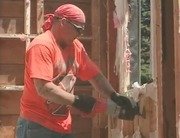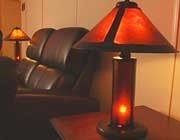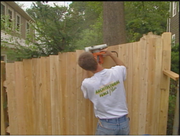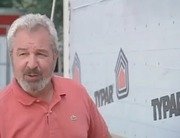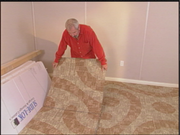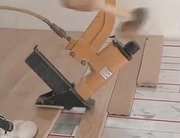So as we enter the backyard Nick, the the choice of hardscape material changes.
What did you use here?
We used these natural, flat field stones because of the relaxed natural feeling back here.
This loose retaining wall was was already installed and existing when we came, and we wanted to do something sort of relaxed to go along with the feel of the backyard as it is.
And so the shape of... I mean this is primarily a functional area to have a table or for kids to play with Tonka toys or whatever.
The shape of it is sort of defined by the slope you're saying?
We've kind of kept it free form just like the wall is against the slope.
And, they are just laid in stone dust?
Correct.
There's no real concrete or cement involved in any of it.
It's all dry laid materials with the compacted stone dust underneath everything holding it all together, and then a layer of the pea stone again on top.
But the choice of the pea stone is one of the important things too, because sometimes you just say get me half inch gravel and whatever, and it's blue-grey, what is this mixture?
This is a natural bank run mix that's screened.
So it's got all the natural colors from the native area.
It's not crushed.
You can see that it's still sort of smooth pebble instead of a crushed aggregate, which is smaller pebbles from the crushings of larger stones.
It's a great, great choice.
It's a very good collaboration between you guys, congratulations.
Let me ask you one last question, Ruth, in terms of your plant material choices here.
It's autumn, a lot of things are dying back, but what's the logic in terms of what you've put on the bank?
This is, we got all of these plants from Monrovia.
They're one of the largest plant suppliers to local nurseries all over the country and they have a number growing stations where they grow very specialized plants.
They're absolutely beautiful plants.
I was here earlier in the season with some blooms of the hydrangeas so we could work in the colors.
So our cedar will weather and we will have all the beautiful growth of the flowers.
Yes.
Thank you both.
It's a beautiful job.
Now, all this natural stuff meets high tech stuff on this other side of the garden.
And we've got two interesting products that have been used here.
The first one, is a product that we've installed along the perimeter of the fence.
OK, so we're gonna look at a product that's been developed to help control weeds along a fence line.
And Jack Shriner's with us from Bruckman Rubber Company out in Nebraska.
Now you guys were what, the government asked you to develop this?
Well the Department of Environmental Quality in Nebraska had asked us to start developing products that would utilize some of the scrap tire to clean up the environment.
So this is one of the products, the Weed Seal, that we developed that utilizes about 50% scrap tire and 50% virgin material special formulas.
So it allows it to seal together when you install the pieces.
So it's basically 100% rubber?
100% rubber with fiber reinforcement.
And tough.
So the idea is that you just lay, we interrupted you here.
But you're just laying it down along the perimeter of the fencing.
Yes, we'll lay it under.
We'll cut the sections for between the posts and we'll lay those sections between the posts.
It's heavy.
Yes.
1.6 pounds, so it won't blow away.
It won't blow away.
It will stay here.
And you can can see by the density of it, nothing's gonna grow though it.
Well, what I like is the concept is that you're not gonna be trimming or edging with a weed whacker and banging up the nice cedar fence.
We even had the EPA talk to us, but, you know, so much spray goes down that harms our environment and gets down to our groundwater when people spray their fences.
And this gives a...
Oh, with pest with a weed controlling chemical.
Yeah, it's the very dangerous stuff that gets put on our soil.
What are these prevents that.
What are these square ones for?
These square ones are what we call our post protectors and they 're designed to go around, to... We have we what we call a slitlock device, designed to go around the post on an existing installation.
Say that you can put it on there.
Yeah.
This particular one here had a conduit coming up so we required another cut on it, so...
An extra notch on it.
Right, a notch on it.
But, this is put in.
We can slip this around there, and then go around the other side and...
So you're not gonna have have anything seed itself at the post either?
Right.
Well that looks great.
It's a terrific product.
Thanks, Jack.
You're welcome.
Thank you.
And at the other end of the little back yard, we've got a totally difference concept.
Greg Gaiter is with us from New Grass, and when we started this project back here, and remember, this family has two little kids, four and five years old, and they are rough on it.
But there are also two big trees back here lots of shade and you couldn't grow grass.
So, that is the reason that you're seeing new grass going down here, and Greg, let's talk about it, because a lot of people have a stigma for artificial turf products, and that it's kinda rough on your knees, or you think about it in terms of football fields.
This is a new approach isn't it?
Yes it is Bob, the new grass product we're putting in here features two different types of blades, we have a soft mono-filament, and a twisted fiber that adds a little cushioning to the product.
It's soft, it's durable.
It is, yeah.
Children love it, pets love it.
You don't have to mow it.
No mowing.
You don't have to water it.
Exactly.
Yeah.
Now, what is it made out of?
The fibers are polyethylene and the back in is a urethane.
It's very durable.
It has a UV coating that has a warranty of ten years.
And what about water puddling on it, do you have to worry about, I mean does the water filter through it?
It filters through it rate of 30 gallons per hour.
Oh, so that's not a problem.
Now we're going to lay out the new grass.
Cut it to shape.
We're going to have one seam that's nearly invisible upon completion.
OK.
Then we'll stake the perimeter so it doesn't lift up.
Broom up the fibers.
And you're set for 10 years or more of a beautiful new grass lawn.
Does it come with a warranty?
It does, yes.
OK, well Greg, this looks like the regular kind of seaming process that you do with wall-to-wall carpet inside the house.
Yes, it certainly is.
So we're getting it prepared to do our initial seaming of the two pieces.
Now, with the pieces put together, you can see we have a nearly invisible seam.
Once we do the final brooming, it will be nearly impossible to see what work we've done.
Greg, what about the cost of this?
The cost for this new grass rye is $4.99 a square foot.
Installation is customer project specific.
Well, this is a very specific project and it works really well.
Thanks a lot.
Thank you very much.
OK.

